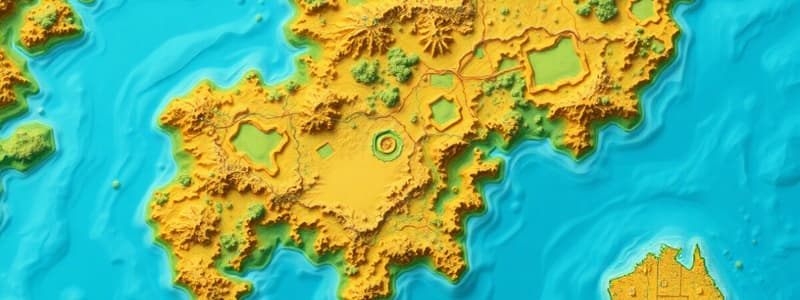Podcast
Questions and Answers
Which of the following correctly describes a choropleth map?
Which of the following correctly describes a choropleth map?
- A thematic map that employs colors or patterns to represent statistical variables. (correct)
- A map that uses isolines to represent temperature variations.
- A map that highlights physical features like mountains and rivers.
- A type of map that displays roads and highways.
What is the primary purpose of a legend on a map?
What is the primary purpose of a legend on a map?
- To explain the symbols and colors used on the map. (correct)
- To serve as the title of the map.
- To indicate the direction of north.
- To provide a scale for distance measurement.
In the RGB color model, what does a value of 0 indicate for a primary color?
In the RGB color model, what does a value of 0 indicate for a primary color?
- The maximum brightness of that color.
- The absence of that color. (correct)
- Medium brightness of that color.
- A light shade of that color.
What is a common characteristic of contour maps?
What is a common characteristic of contour maps?
Which of the following methods is NOT recommended for color representation in mapping?
Which of the following methods is NOT recommended for color representation in mapping?
What type of data is primarily indicated by the use of unique color to map into distinct groups?
What type of data is primarily indicated by the use of unique color to map into distinct groups?
Which mapping approach is most appropriate for representing ordinal data?
Which mapping approach is most appropriate for representing ordinal data?
Which of the following is NOT a characteristic of discrete raster data?
Which of the following is NOT a characteristic of discrete raster data?
Interval and ratio data both require which step before mapping?
Interval and ratio data both require which step before mapping?
What characteristic best defines continuous raster data?
What characteristic best defines continuous raster data?
Why is color generally more effective than shape in data symbolization?
Why is color generally more effective than shape in data symbolization?
Which of the following best describes nominal data?
Which of the following best describes nominal data?
Which of the following is NOT a common type of coordinate system?
Which of the following is NOT a common type of coordinate system?
Which characteristic is true about large scale maps?
Which characteristic is true about large scale maps?
What is a key advantage of vector data models compared to raster data models?
What is a key advantage of vector data models compared to raster data models?
Which principle refers to the relationship between neighboring polygons?
Which principle refers to the relationship between neighboring polygons?
Which feature of raster data models is a disadvantage?
Which feature of raster data models is a disadvantage?
Which of the following is a type of raster data?
Which of the following is a type of raster data?
What can vectors store information about?
What can vectors store information about?
What is a significant disadvantage of using vector data models for representing continuous data?
What is a significant disadvantage of using vector data models for representing continuous data?
What does the principle of connectivity ensure in a spatial network?
What does the principle of connectivity ensure in a spatial network?
Flashcards
Choropleth Map
Choropleth Map
A thematic map using shaded or patterned areas to show data values in relation to statistical measurements.
Isoline
Isoline
A line on a map that connects points of equal value, like temperature, elevation, or rainfall.
Contour Map
Contour Map
A type of map using isolines to represent elevation or the shape of the land.
RGB Color Model
RGB Color Model
Signup and view all the flashcards
Color Contrast
Color Contrast
Signup and view all the flashcards
Nominal Data
Nominal Data
Signup and view all the flashcards
Ordinal Data
Ordinal Data
Signup and view all the flashcards
Categorical Data
Categorical Data
Signup and view all the flashcards
Interval Data
Interval Data
Signup and view all the flashcards
Ratio Data
Ratio Data
Signup and view all the flashcards
Discrete Raster Data
Discrete Raster Data
Signup and view all the flashcards
Continuous Raster Data
Continuous Raster Data
Signup and view all the flashcards
Cartesian Coordinate System
Cartesian Coordinate System
Signup and view all the flashcards
What are the basic building blocks of vector data?
What are the basic building blocks of vector data?
Signup and view all the flashcards
What is a node?
What is a node?
Signup and view all the flashcards
What is a vertex?
What is a vertex?
Signup and view all the flashcards
What are the four principles of vector topography?
What are the four principles of vector topography?
Signup and view all the flashcards
What is the main difference between raster and vector data?
What is the main difference between raster and vector data?
Signup and view all the flashcards
What is a raster cell's resolution?
What is a raster cell's resolution?
Signup and view all the flashcards
What is the main advantage of vector data?
What is the main advantage of vector data?
Signup and view all the flashcards
What are the main advantages of raster data?
What are the main advantages of raster data?
Signup and view all the flashcards
Study Notes
Spatial Data Models
- Spatial data models represent objects in a spatial database and their relationships
- They provide formal methods for representing and manipulating spatially referenced information
Vector Data Models
- Vector data models represent real-world features as points, lines, and polygons
- Vertices define the points of lines and the corners of polygons
- Examples of Vector data models include: points (e.g., locations of schools), lines (e.g., roads), and polygons (e.g., parks)
Raster Data Models
- Raster data models represent features as a grid of cells (pixels)
- Each cell has a value corresponding to the feature at that location
- Examples of Raster data include satellite images, elevation maps, and land cover maps
Discrete Data
- Discrete data exists at specific locations within a defined space
- Examples include: Lookout towers, streams, and snail habitats
Continuous Data
- Continuous data exists everywhere within a specified space
- Examples include elevation and precipitation
Vector Data Model Shapes
- Points: represent location only (e.g., points)
- Lines: represent length and are connected points (e.g., roads)
- Polygons: represent enclosed areas (e.g., parks, lakes)
Vector Topography Principles
- Connectivity: lines and points are connected
- Adjacency: relationship between neighboring polygons
- Containment: one polygon entirely enclosed within another
Raster Data Types
- Land cover
- Terrain
- Satellite images
Raster Model Pros & Cons
- Pros: faster, easier to understand, easier to print
- Cons: less accurate, lines can become fat, only one value per cell
Scale Maps
- Small scale maps show less detail (e.g., 1:300,000)
- Large scale maps show more detail (e.g., 1:1,000)
Cartographic Design
- Principles relate to data plotting (scale, size, shape, patterns), labeling (font, size), legend (properties, size, and borders)
Common Map Elements
- Title, focal element, supportive elements (legend, scale bar, north arrow), balance (elements equally weighted)
Choropleth Maps
- Choropleth maps use shading or patterns to represent data values in proportion
Isolines
- Isolines: lines connecting points of equal value (e.g., contour lines on maps)
Contour Maps
- Contour maps use isolines to show elevation and terrain shape
RGB Color Models
- Represent colors as mixtures of red, green, and blue, with brightness on a scale of 0-255
- White is full intensity of all colors
Color Contrast and Harmonies
- High contrast: colors opposite each other on the color wheel
- Low contrast: colors next to each other on the color wheel
- Complementary, Analogous
Color Selection for Maps
- Use different colors for categories, shades of same color for quantities, and shades of two colors for diverse quantities
Attribute Types
- Nominal: names or unique identifiers (e.g., county names)
- Ordinal: rank categories (e.g., snail habitat suitability)
- Categorical: distinct groups or classes (e.g., rock type)
- Interval: numeric scale with a meaningful zero point (e.g., temperature)
- Ratio: numeric scale with a true zero point (e.g., population)
Data Representation Methods
- Nominal data: single symbol map
- Categorical data: unique colors
- Ordinal data: unique values or graduated colors
- Interval & Ratio Data: divide into classes, varying size and thickness of symbols, hue
Data Symbolization Principles
- Brain seeks patterns
- Color over shape
Coordinate Systems
- Spherical: latitude and longitude
- Cartesian: numerical coordinates
Datum
- Datum: reference for a system of coordinates that defines the size and shape of the earth, and its location
- Ellipsoid: model of the earth's shape used to create a surface for mapping computations
Horizontal and Vertical Datums
- Horizontal datum: coordinates of specific locations (longitude/latitude)
- Vertical datum: a reference surface in measuring elevation
Coordinate System Types
- Local or world-centered data
Geoid
- Model of global mean sea level used to measure elevation precisely
- It is closest to the true shape of the Earth
Spheroid
- A simplified 3D geometric shape of the Earth that is easier to work with mathematically
- It is a good approximation of the Earth's shape
Map Projections
- Project a spherical Earth onto a flat map surface preserving either shape, area, direction or distance (but not all at once)
Studying That Suits You
Use AI to generate personalized quizzes and flashcards to suit your learning preferences.




